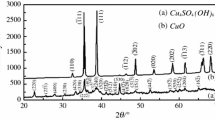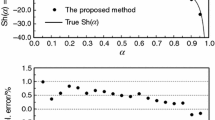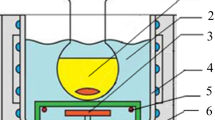Abstract
The oscillatory behavior is not the only interesting nonlinear phenomena that appeared in the Briggs–Rauscher (BR) reaction. The BR reaction containing malonic acid may undergo a sudden transition from low (the state I) to high iodide and iodine (the state II) concentration states. This paper focuses on the mixture with an immutable [CH2(COOH)2]0/[IO3 −]0 = 1.5 value, where state I to state II transition occurs after a time delay and BR reaction ended with a solution abundant of solid iodine. The state I to the state II transition curves obtained at different temperatures were analyzed using the Kolmogorov–Johnson–Mehl–Avrami (KJMA) theory. The KJMA theory was applied for monitoring the crystallization process of isolated solid iodine product at various levels of operating temperatures. At T < 33.5 °C, we have one type of the process and iodine was formed by autocatalysis pathway. On the other hand, at T ≥ 33.5 °C, two processes occur. With the rise in operating temperature, the emergence of inhomogeneous distribution of nuclei was identified and it was established the primary and secondary crystallization processes of iodine. At elevated temperatures, it was also found that the strong influence of impingement mechanism exists. Results obtained are the first step toward elucidation of the complex reaction mechanism of the state I → state II transition.






Similar content being viewed by others
References
Briggs TS, Rauscher WC (1973) An oscillating iodine clock. J Chem Educ 50:496
Furrow SD, Noyes RM (1982) The oscillatory Briggs–Rauscher reaction. 1. Examination of subsystems. J Am Chem Soc 104:38–42
Noyes RM, Furrow SD (1982) The oscillatory Briggs–Rauscher reaction. 3. A skeleton mechanism for oscillations. J Am Chem Soc 104:45–48
Furrow SD (2012) A modified recipe and variations for the Briggs–Rauscher oscillating reaction. J Chem Educ 89:1421–1424
Furrow SD, Cervellati R, Amadori G (2002) New substrates for the oscillating Briggs–Rauscher reaction. J Phys Chem A 106:5841–5850
Furrow SD, Aurentz DJ (2010) Reactions of iodomalonic acid, diiodomalonic acid, and other organics in the Briggs–Rauscher oscillating system. J Phys Chem A 114(7):2526–2533
Bray WC (1921) A periodic reaction in homogeneous solution and its relation to catalysis. J Am Chem Soc 43(6):1262–1267
Bray WC, Liebhafsky HA (1931) Reactions involving hydrogen peroxide, iodine and iodate ion. I. Introduction. J Am Chem Soc 53:38–44
Schmitz G, Furrow S (2012) Kinetics of the iodate reduction by hydrogen peroxide and relation with the Briggs–Rauscher and Bray–Liebhafsky oscillating reactions. Phys Chem Chem Phys 14:5711–5717
De Kepper P, Epstein IR (1982) Mechanistic study of oscillations and bistability in the Briggs–Rauscher reaction. J Am Chem Soc 104:49–55
Vukojević V, Sørensen PG, Hynne FJ (1996) Predictive value of a model of the Briggs–Rauscher reaction fitted to quenching experiments. J Phys Chem 100:17175–17185
Turányi T (1991) Rate sensitivity analysis of a model of the Briggs–Rauscher reaction. React Kinet Catal Lett 45:235–241
Kim KR, Shin KJ, Lee Dong J (2004) Complex oscillations in a simple model for the Briggs–Rauscher reaction. J Chem Phys 121:2664–2672
Čupić Ž, Lj Kolar-Anić, Anić S, Maćešić S, Maksimović J, Pavlović M, Milenković M, Bubanja IN, Greco E, Furrow SD, Cervellati R (2014) Regularity of intermittent bursts in Briggs–Rauscher oscillating system with phenol. Helv Chim Acta 97:321–333
Bishop MKJ, Fialkowski M, Grzybowski BA (2005) Micropatterning chemical oscillations: waves, autofocusing, and symmetry breaking. J Am Chem Soc 127:15943–15948
Furrow SD, Cervellati R, Greco E (2012) A Study of the cerium-catalyzed Briggs-Rauscher oscillating reaction. Z Naturforsch 67b:89–97
Cervellati R, Höner K, Furrow SD, Neddens C, Costa S (2001) The Briggs–Rauscher reaction as a test to measure the activity of antioxidants. Helv Chim Acta 84(12):3533–3547
Rinaldo C, Renzulli C, Guerra MC, Speroni E (2002) Evaluation of antioxidant activity of some natural polyphenolic compounds using the Briggs–Rauscher reaction method. J Agric Food Chem 50:7504–7509
Cervellati R, Furrow SD (2007) Perturbations of the Briggs–Rauscher oscillating system by iron-phenanthroline complexes. Inorg Chim Acta 360:842–848
Stanisavljev D, Milenković MC, Mojović M, Popović-Bijelić A (2011) Oxygen centered radicals in iodine chemical oscillators. J Phys Chem A 115(27):7955–7958
Stanisavljev DR, Milenković MC, Popović-Bijelić AD, Mojović MD (2013) Radicals in the Bray–Liebhafsky oscillatory reaction. J Phys Chem A 117(16):3292–3295
Milenković MC, Potkonjak NI (2014) The effect of hydroxycinnamic acids on oxy-radical generating iodide-hydrogen peroxide reaction. Bull Chem Soc Jpn 87(11):1255–1259
Pagnacco MC, Mojović MD, Popović-Bijelić AD, Horváth AK (2017) Investigation of the halogenate-hydrogen peroxide reactions using the electron paramagnetic resonance spin trapping technique. J Phys Chem A 121(17):3207–3212
Furrow SD, Cervellati R, Greco E (2016) Study of the transition to higher iodide in the malonic acid Briggs–Rauscher oscillator. Reac Kinet Mech Cat 118:59–71
Kolmogorov AN (1937) On the statistical theory of crystallization of metals. Izv Akad Nauk SSSR Ser Mat 3:355–359
Johnson WA, Mehl RF (1939) Reaction kinetics in processes of nucleation and growth. Trans Am Inst Min (Metall) Eng 135:416–442
Avrami M (1939) Kinetics of phase change. I. General theory. J Chem Phys 7:1103–1112
Avrami M (1940) Kinetics of phase change. II. Transformation-time relations for random distribution of nuclei. J Chem Phys 8:212–224
Avrami M (1941) Kinetics of phase change. III. Granulation, phase change, and microstructure. J Chem Phys 9:177–184
Khawam A, Flanagan DR (2006) Solid-state kinetic models: basics and mathematical fundamentals. J Phys Chem B 110:17315–17328
Biswas K, Ram S, Schultz L, Eckert J (2005) Crystallization kinetics of amorphous Fe67Co9.5Nd3Dy0.5B20. J Alloys Compd 397:104–109
Ruitenberg G, Petford-Long AK, Doole RC (2002) Determination of the isothermal nucleation and growth parameters for the crystallization of thin Ge2Sb2Te5 films. J Appl Phys 92:3116–3123
Brown ME, Dollimore D, Galwey AK (1980) Theory of solid state reaction kinetics. Compr Chem Kinet 22:41–113
Friedman HL (1964) Kinetics of thermal degradation of char-forming plastics from thermogravimetry. Application to a phenolic plastic. J Polym Sci C 6:183–195
Kempen ATW, Sommer F, Mittemeijer EJ (2002) Determination and interpretation of isothermal and non-isothermal transformation kinetics. The effective activation energies in terms of nucleation and growth. J Mater Sci 37:1321–1332
Vanag VK, Alfimov MV (1993) Light-induced nonequilibrium phase transition between quasistationary states of the Briggs–Rauscher reaction under batch conditions. J Phys Chem 97:1878–1883
Vanag VK, Alfimov MV (1993) Effects of stirring on photoinduced phase transition in a batch-mode Briggs–Rauscher reaction. J Phys Chem 97:1884–1890
Stanisavljev DR, Dramićanin MD (2007) Excessive excitation of hydrogen peroxide during oscillatory chemical evolution. J Phys Chem A 111(32):7703–7706
Stanisavljev DR (2010) Energy dynamics in the Bray–Liebhafsky oscillatory reaction. J Phys Chem A 114(2):725–729
Sun NX, Liu XD, Lu K (1996) An explanation to the anomalous Avrami exponent. Scr Mater 34:1201–1207
Skrdla PJ, Robertson RT (2005) Semiempirical equations for modeling solid-state kinetics based on a Maxwell-Boltzmann distribution of activation energies: applications to a polymorphic transformation under crystallization slurry conditions and to the thermal decomposition of AgMnO4 crystals. J Phys Chem B 109:10611–10619
Ghilani CD (2010) Adjustment computations: spatial data analysis, 5th edn. Wiley, Hoboken
Kooi BJ (2004) Monte Carlo simulations of phase transformations caused by nucleation and subsequent anisotropic growth: extension of the Johnson–Mehl–Avrami–Kolmogorov theory. Phys Rev B 70:224108
Acknowledgements
The present investigations were supported by The Ministry of Education, Science and Technological Development of the Republic of Serbia, under Project 172015.
Author information
Authors and Affiliations
Corresponding author
Electronic supplementary material
Below is the link to the electronic supplementary material.
Rights and permissions
About this article
Cite this article
Pagnacco, M.C., Maksimović, J.P. & Janković, B.Ž. Analysis of transition from low to high iodide and iodine state in the Briggs–Rauscher oscillatory reaction containing malonic acid using Kolmogorov–Johnson–Mehl–Avrami (KJMA) theory. Reac Kinet Mech Cat 123, 61–80 (2018). https://doi.org/10.1007/s11144-017-1288-6
Received:
Accepted:
Published:
Issue Date:
DOI: https://doi.org/10.1007/s11144-017-1288-6




